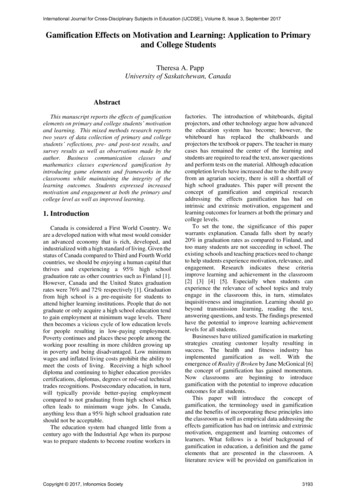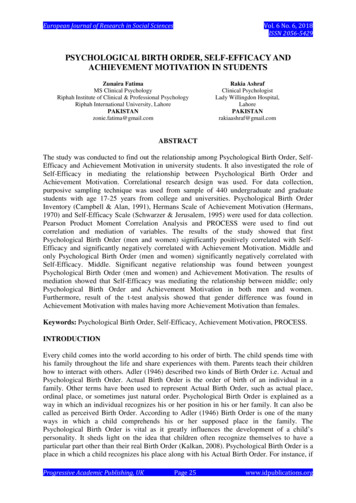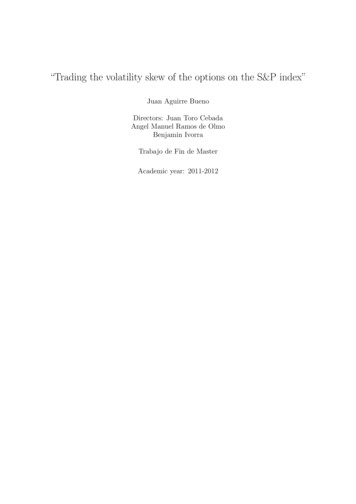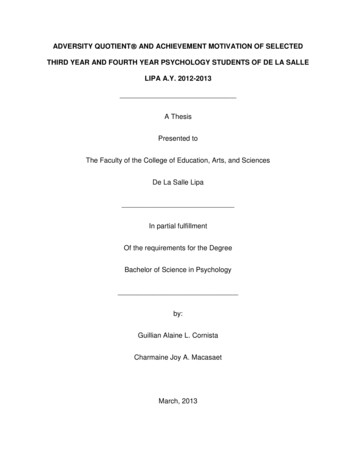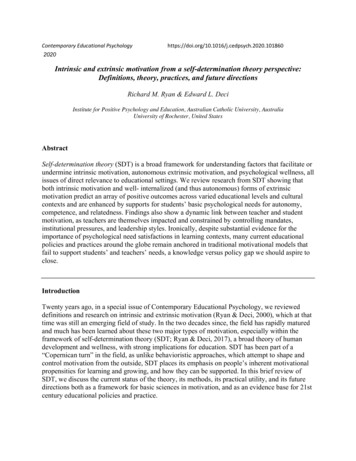
Transcription
Contemporary Educational 1018602020Intrinsic and extrinsic motivation from a self-determination theory perspective:Definitions, theory, practices, and future directionsRichard M. Ryan & Edward L. DeciInstitute for Positive Psychology and Education, Australian Catholic University, AustraliaUniversity of Rochester, United StatesAbstractSelf-determination theory (SDT) is a broad framework for understanding factors that facilitate orundermine intrinsic motivation, autonomous extrinsic motivation, and psychological wellness, allissues of direct relevance to educational settings. We review research from SDT showing thatboth intrinsic motivation and well- internalized (and thus autonomous) forms of extrinsicmotivation predict an array of positive outcomes across varied educational levels and culturalcontexts and are enhanced by supports for students’ basic psychological needs for autonomy,competence, and relatedness. Findings also show a dynamic link between teacher and studentmotivation, as teachers are themselves impacted and constrained by controlling mandates,institutional pressures, and leadership styles. Ironically, despite substantial evidence for theimportance of psychological need satisfactions in learning contexts, many current educationalpolicies and practices around the globe remain anchored in traditional motivational models thatfail to support students’ and teachers’ needs, a knowledge versus policy gap we should aspire toclose.IntroductionTwenty years ago, in a special issue of Contemporary Educational Psychology, we revieweddefinitions and research on intrinsic and extrinsic motivation (Ryan & Deci, 2000), which at thattime was still an emerging field of study. In the two decades since, the field has rapidly maturedand much has been learned about these two major types of motivation, especially within theframework of self-determination theory (SDT; Ryan & Deci, 2017), a broad theory of humandevelopment and wellness, with strong implications for education. SDT has been part of a“Copernican turn” in the field, as unlike behavioristic approaches, which attempt to shape andcontrol motivation from the outside, SDT places its emphasis on people’s inherent motivationalpropensities for learning and growing, and how they can be supported. In this brief review ofSDT, we discuss the current status of the theory, its methods, its practical utility, and its futuredirections both as a framework for basic sciences in motivation, and as an evidence base for 21stcentury educational policies and practice.
As an organismic theory, SDT assumes people are inherently prone toward psychological growthand integration, and thus toward learning, mastery and connection with others. However, theseproactive human tendencies are not seen as automatic—they require supportive conditions to berobust. SDT specifically argues that for healthy development to unfold individuals requiresupports for basic psychological needs (Ryan, Ryan, Di Domenico, & Deci, 2019). Three needsare seen as particularly fundamental, namely those for autonomy, competence and relatedness.Autonomy concerns a sense of initiative and ownership in one’s actions. It is supported byexperiences of interest and value and under- mined by experiences of being externally controlled,whether by re- wards or punishments. Competence concerns the feeling of mastery, a sense thatone can succeed and grow. The need for competence is best satisfied within well-structuredenvironments that afford optimal challenges, positive feedback, and opportunities for growth.Finally, relatedness concerns a sense of belonging and connection. It is facilitated by conveyanceof respect and caring. Thwarting of any of these three basic needs is seen as damaging tomotivation and wellness. Accordingly, SDT’s analysis of educational settings is primarilyfocused on the extent to which they meet or frustrate these basic needs.OverviewOf interest in this review are the effects of SDT’s basic psychological need satisfactions andsupports in the classroom on both intrinsic and extrinsic motivational processes, and students’well-being and academic performance. First, we revisit classic definitions of intrinsic andextrinsic motivation, before reviewing contemporary research on how these motivations areaffected by classroom practices, especially teachers’ support of learners’ basic psychologicalneeds. SDT argues that need supports enhance intrinsic motivation and internalization, resultingin higher achievement, whereas, paradoxically, attempting to control achievement outcomesdirectly through extrinsic rewards, sanctions, and evaluations generally backfires, leading tolower-quality motivation and performance.Yet more important than achievement outcomes, in our view, is students’ psychological growthand wellness. Although not all students can or will excel at the cognitive agendas that are thecentral focus in many schools, schools should nonetheless be supportive contexts fordevelopment, provide conditions that enhance students’ adaptive capacities and mental health,and, importantly, do no harm. SDT research shows that support for basic psychological needsfosters students’ wellness, a pattern evident across age, ethnicity, and culture, and that needthwarting causes harms. Basic need support is especially important given the diversity oflearners, and we discuss the particularly central role of autonomy support in fostering inclusiveenvironments. We also consider how an atmosphere conducive to thriving students requiresthriving teachers, and thus the importance of supporting teachers’ basic psychological needs.Finally, we discuss the gap between many educational policies and practices around the globeand the empirically identified needs of students and teachers. We conclude with considering thefuture directions SDT research, interventions, and theorizing may take.Intrinsic and extrinsic motivation within SDTIntrinsic motivation
SDT research began with a focus on intrinsic motivation, which is a prototypical expression ofthe active integrative tendencies in human nature assumed by SDT. Technically intrinsicmotivation pertains to activities done “for their own sake,” or for their inherent interest andenjoyment (Deci & Ryan, 2000). Play, exploration and curiosity- spawned activities exemplifyintrinsically motivated behaviors, as they are not dependent on external incentives or pressure,but rather provide their own satisfactions and joys. Although “fun,” such inherent propensitiestoward interested engagement and mastery are also serious organismic business; intrinsicmotivation is likely responsible for the preponderance of human learning across the life span, asopposed to externally mandated learning and instruction (Ryan & Deci, 2017).The benefits of intrinsic motivation are also obvious within formal education. For example, ameta-analysis by Taylor et al. (2014) pointed to a significant role of intrinsic motivation inschool achievement. Taylor et al. followed this meta-analysis with additional studies of highschool and college students in Canada and Sweden, showing that intrinsic motivation wasconsistently associated with higher performance, controlling for baseline achievement. Froilandand Worrell (2016) convergently showed that intrinsic motivation predicted student engagement,which, in turn, predicted higher achievement (GPA), results that remained consistent whenlimiting analyses to African American and Latino students.Despite such findings attesting to the importance of intrinsic motivation, research from multiplecountries suggests that it tends to decline over the school years—at least for school-relatedactivities (e.g., Lepper, Corpus, & Iyengar, 2005; Gillet, Vallerand, & Lafreniere, 2012;Gottfried, Marcoulides, Gottfried, Oliver, & Guerin, 2007; Scherrer & Preckel, 2019). Thissuggests to us that schools are not creating the need-supportive contexts that foster this innerresource, an interpretation supported by Gnambs & Hanfstingl, 2016 analysis showing thatdeclines in intrinsic motivation are associated with decreasing psychological need satisfaction.Extrinsic motivationOften contrasted with intrinsic motivation is the heterogeneous category of extrinsic motivation,which concerns behaviors done for reasons other than their inherent satisfactions. From an SDTview the contrast is not a simple one, because instrumental motivations can vary widely incontent and character. Accordingly, SDT has long specified four major subtypes of extrinsicmotivation, illustrated in Figure 1. External regulation concerns behaviors driven by externallyimposed re- wards and punishments and is a form of motivation typically experienced ascontrolled and non-autonomous. Introjected regulation concerns extrinsic motivation that hasbeen partially internalized; behavior is regulated by the internal rewards of self-esteem forsuccess and by avoidance of anxiety, shame, or guilt for failure. In academic activitiesintrojected regulation often takes the form of ego-involvement (Ryan, 1982) in which selfesteem is contingent on outcomes, resulting in “internally controlled” regulation.Whereas both external regulation and introjection represent con- trolled forms of motivation,extrinsic motivation can also be autonomously enacted. In identified regulation, the personconsciously identifies with, or personally endorses, the value of an activity, and thus experiencesa relatively high degree of volition or willingness to act. Yet the most autonomous form ofextrinsic motivation is integrated regulation in which the person not only recognizes and
identifies with the value of the activity, but also finds it to be congruent with other core interestsand values. Autonomous extrinsic motivations share with intrinsic motivation the quality ofbeing highly volitional, but differ primarily in that intrinsic motivation is based in interest andenjoyment—people do these behaviors because they find them engaging or even fun, whereasidentified and integrated motivations are based on a sense of value—people view the activities asworthwhile, even if not enjoyable. Fig. 1 also depicts a sixth category of amotivation, whichrefers to lacking intentionality. Amotivation, all too common in class- room settings, can resultfrom either lack of felt competence to perform, or lack of value or interest. Amotivation has beena strong negative predictor of engagement, learning, and wellness.Multiple motives and relative autonomyAlthough differing in character and content, these varied forms of motivation or regulatory stylesare arranged in Figure 1 along a continuum reflecting their relative autonomy. Much research hasverified the “ordered” relations among categories consistent with the SDT relative autonomymodel (e.g., Chatzisarantis, Hagger, Biddle, Smith, & Wang, 2003; Howard, Gagné, & Bureau,2017). Yet SDT also recognizes that most intentional behaviors are multiply motivated (e.g., seeLitalien et al., 2017). People can, for example, be simultaneously intrinsically motivated andidentified for some actions, or both externally regulated and introjected, etc. Thus, in addition tolooking at the unique properties of each motive type, scores reflecting either overall relative autonomy or summary scores for autonomous and controlled motives are often applied (see Ryan& Deci, 2017). There is also a growing interest in person-centered analyses in which profiles ofmotivation are generated (e.g., Wang et al., 2017). However assessed, data show that greaterrelative autonomy for learning (or teaching) predicts a variety of key educational outcomes, aswe shall further review.SDT research on intrinsic and extrinsic motivations in classroomsAmong the core hypotheses of SDT in education are that: (a) more autonomous forms ofmotivation will lead to an enhancement of students’ engagement, learning, and wellness; and (b)that basic psycho- logical need support from both teachers and parents facilitates suchmotivation, whereas need thwarting undermines it. These hypotheses have been well supportedacross hundreds of studies, at every level of development, and across varied learning contentsand cultural contexts.First, a large empirically-based literature has demonstrated the positive relations of moreautonomous forms of classroom motivation with academic outcomes (Howard et al., 2017;Grolnick, Ryan, & Deci, 1991; Guay, Ratelle, Roy, & Litalien, 2010; Katz, Eilot, & Nevo, 2014;Grolnick & Ryan, 1989; and others). This is likely due in part to the greater effort students putforth when autonomously motivated (León, Núñez, & Liew, 2015). In addition, the moreinternalized the motivation, the more it becomes part of a learner’s identity. For example,Skinner, Saxton, Currie, and Shusterman (2017) showed that basic need satisfaction wasassociated not only with higher engagement and performance in STEM courses, but also greateridentification of oneself as a scientist.
Second, basic psychological need supports have shown robust positive effects on schooloutcomes. Studies show that students of more autonomy-supportive teachers have more intrinsicmotivation, perceived competence, and self-esteem (e.g., Deci, Schwartz, Sheinman, & Ryan,1981; Ryan & Grolnick, 1986), better grades (Guay & Vallerand, 1997) greater internalizationfor learning activities, and lower dropout (e.g., Hardré & Reeve, 2003; Vallerand, Fortier, &Guay, 1997). In college, Black and Deci (2000) showed that STEM students rating labinstructors as more autonomy supportive showed increases in autonomous motivation andperceived competence, and received higher grades, controlling for prior GPA and SAT scores.Manganelli et al. (2019) found that college students’ autonomous motivation predicted bothhigher academic performance beyond the effects of prior achievement. Núñez and León (2019)in a prospective study of Spanish collegians, showed that perceived autonomy support led togreater engagement, mediated by autonomous motivation.SDT applies as well within advanced educational contexts. For ex- ample, Williams, Saizow,Ross, and Deci (1997) found that mentors’ autonomy support for medical students predicted theareas the students selected for their residencies. Sheldon and Krieger (2007) investigated lawstudents over their three years of study. Overall, law students re- ported a decline in basicpsychological need satisfaction and well-being during this time. Yet, if they had more autonomysupportive instructors they showed less decline in need satisfaction and well-being. Moreover,those who experienced more autonomy support in law school received higher grades, performedbetter on the bar exam, and reported higher autonomy in post-graduation employment.Reeve and Tseng (2011) looked into the potential biological mediators at work in these effects ofautonomy-supportive versus control- ling teaching. They exposed students to one of threeconditions in which teachers were autonomy-supportive, neutral, or controlling. They thenassessed salivary cortisol, which is indicative of stress. Stu- dents exposed to a controllingteacher had higher cortisol than those in the neutral condition, whereas those exposed toautonomy-supportive teaching had lower cortisol than those in the neutral condition. Streb et al.(2015) found, oppositely, that when children were in learning environments that emphasizedsocial relatedness and autonomy sup- port (e.g., kindergarten vs. schools; voluntary workshopsvs. regular lessons) they showed higher heart rates and emotional arousal indictive of greaterengagement and energy mobilization. Such results how a need-supportive context can incite themore vital engagement associated with autonomous motivation.Need-supportive teaching behaviorsNumerous studies across multiple settings show advantages of need- supportive classroomclimates in catalyzing more autonomous student motivation. But what does such need supportlook like? Within SDT there has been much interest in the specific ingredients of facilitatingenvironments, many of which were initially identified through experimental studies (see Ryan &Deci, 2017). These ingredients primarily concern the teacher’s provision of autonomy supportand structure. Autonomy support is seen as promoting both autonomy and relatednesssatisfactions, and when it occurs along with structure, competence as well.Autonomy support
Teachers who support students’ autonomy begin by attempting to understand, acknowledge, andwhere possible, be responsive to students’ perspectives. They also try to provide opportunitiesfor students to take ownership and initiative of their schoolwork, providing them withmeaningful choices and tasks that can engage their interests. When they require something to bedone, they provide a meaningful rationale. In contrast, controlling teachers are more oriented topressure students to think, feel, or behave in particular ways without responsiveness to studentperspectives.Another factor that can support autonomy is the provision of choice. SDT suggests that whenstudents experience a sense of choice they feel more ownership of activities and greaterautonomy, resulting in an enhanced intrinsic motivation (e.g., Bao & Lam, 2008; Reeve, Nix, &Hamm, 2003). Moreover, choice can facilitate performance (e.g., Murayama et al., 2015), andcuriosity, especially for those initially low in autonomy (Schutte & Malouff, 2019). Yet not alltypes of choice are associated with the experience of autonomy. There can be meaninglesschoices such as choices between options a person doesn’t want, or choices with subtle pressuresimplicit in them (e.g., Assor, Kaplan, & Roth, 2002; Moller, Deci, & Ryan, 2006). Conversely,one can have no options and still feel autonomy, if one willingly accepts the value of, or hasinterest in, pursuing the available behavior. Nonetheless, meta- analytic findings by Patall,Cooper, and Robinson (2008) support the general SDT hypothesis of a positive effect of choiceon intrinsic motivation. Patall, Dent, Oyer, and Wynn (2013) showed further that, along withchoice, teachers can support autonomy by taking students’ interests into account. When they doso, students are also likely to judge them as more competent (Jang, Reeve, & Halusic, 2016).More recently, using a diary method with students in science courses, Patall et al. (2019) foundthat in lessons wherein teachers engaged in autonomy-supportive behaviors such as offeringchoice, providing rationales, focusing on students interests or questions, and other specificautonomy-supportive behaviors, students reported greater interest in the material. Tsai, Kunter,Lüdtke, Trautwein, and Ryan (2008) similarly showed that lesson-to-lesson variations in studentinterest and motivation fluctuated with daily variations in teacher support for autonomy. Multilevel modeling in three subject areas revealed that on days when the teacher was more autonomysupportive than usual, students were more interested than usual in that subject area.Reeve and colleagues have used various empirical approaches to identify aspects of whatautonomy-supportive teachers do. Reeve, Bolt, and Cai (1999) began this work by assessingteachers’ self-reports of autonomy support versus control. The teachers were then videotapedwhile teaching, and their lessons rated. Teachers whose self-reports classified them as moreautonomy supportive were found to listen more, be more responsive to student questions, bringmore attention to student interests, resist giving answers, voice fewer directives, show moresupport for student initiatives, and convey more understanding of students’ perspectives.Subsequently, Reeve and Jang (2006) preidentified specific teacher behaviors that wereautonomy supportive or controlling and related these observed behaviors to the motivation reported by students. Results indicated that eight teacher behaviors that had been categorized asautonomy supportive (listening to students, making time for independent work, giving studentsopportunities to speak, acknowledging improvement and mastery, encouraging effort, offeringprogress-enabling hints when students seem stuck, being responsive to comments and questions,and acknowledging students’ perspectives) were positively associated with students’ autonomous
motivation. In contrast, teacher behaviors categorized as controlling (e.g., monopolizing learningmaterials, telling students answers, issuing directives, using controlling words such as “should”and “have to”) were negatively related with students’ autonomous motivation.Also focusing on this the “dark side” of the motivation puzzle, Assor, Kaplan, Kanat-Maymon,and Roth (2005) showed that controlling behaviors by Israeli teachers predicted lower studentautonomy. In related work, Liu, Bartholomew, and Chung (2017) used multilevel growthmodeling to show that increases in perceptions of controlling teaching were related to increasesin need frustration across the school year which, in turn, were related to lower autonomousmotivation and greater fear of failure, contingent self-worth, and avoidance of challenges.Indirect effects supported the mediating role of need frustration in these relations.Autonomy support and structureSDT strongly distinguishes between the idea of control and the idea of structure, and views themost positive teaching and parenting styles as being high in both autonomy support and structure(e.g., Grolnick et al., 2014; Grolnick & Ryan, 1989; Jang, Reeve, & Deci, 2010). Whereascontrolling behaviors pressure students to behave or achieve, structure entails setting clearexpectations and goals, having consistency in rules and guidelines, and providing informationalsupports for engagement and rich efficacy feedback. Good structure “scaffolds” learning so thatstudents rarely face non-optimal challenges, and feedback is thus largely positive and efficacysupportive. The combi- nation of high teacher autonomy support and structure has beenempirically associated with higher autonomous motivation (both intrinsic and identified), greateruse of self-regulated learning strategies, and lower anxiety (e.g., Hardré & Reeve, 2003;Vansteenkiste et al., 2012).Although structure can especially enhance competence satisfaction, its effects are influenced byhow it is delivered (Soenens & Vansteenkiste, 2010). Structure can be provided in eithercontrolling or autonomy-supportive ways. Indeed, SDT predicts that, both in school and at home,greater internalization and competence are facilitated by high levels of both autonomy-supportand provision of structure. Jang et al. (2010), for example, studied teacher autonomy support andstructure in U.S. high schools, finding that teachers’ autonomy support and structure, as rated byobservers, predicted students’ engagement, as did students’ perceptions of autonomy support.Farkas and Grolnick (2010) showed that parental structure and autonomy support predicted bothfelt competence and autonomy in 7th and 8th-grade children.Various configurations of autonomy-support and structure (and their opposites of control andchaos) can be reliably assessed and used to predict classroom outcomes. For example, Aeltermanet al. (2019) collected self-reports from over 1000 Belgian secondary school teachers andstudents using the vignette-based Situations-in-School Questionnaire, to which they appliedmultidimensional scaling analyses. Results suggested that teaching styles could be representedby a two-dimensional configuration forming a circumplex with eight subareas, namely:participative and attuning, guiding and clarifying, demanding and domineering, and abandoningand awaiting. Correlations between these subareas and various outcome variables followed theexpected sinusoid pattern. Such findings underscore that supporting autonomy is not about
permissiveness, but rather helping to catalyze students’ willingness to engage in learning throughwell-organized learning environments and activities.Work on detailing the specific behaviors that support autonomy, competence and relatedness inclassrooms continues in earnest within SDT, including many studies based on direct classroomobservations (e.g., Haerens et al., 2013; Rogat, Witham, & Chinn, 2014; Wallace, Sung, &Williams, 2014). It is noteworthy that when teachers are autonomy supportive, they are typicallyalso supportive of students’ other basic psychological needs (competence and relatedness) aswell. This of course makes sense insofar as, when teachers are autonomy supportive, they aremore attuned to students’ perspectives, allowing more responsiveness to relational andcompetence concerns.Student wellness and basic need supportsWe have argued that although schools are often narrowly focused on achievement, they are moreimportantly contexts for child, adolescent, and young adult development (Ryan & Deci, 2017).In schools, students acquire not only knowledge, but also a sense of industry and a set ofidentities (positive or negative). Confidence, self-esteem, and mental health are all deeplyaffected by whether what happens in school supports or thwarts basic psychological needs.Tian, Chen, and Huebner (2014), for example, assessed Chinese adolescent students’ basicpsychological needs and their school-related well-being at two time points, approximately sixweeks apart. Analyses revealed relationships between autonomy, relatedness, and competencesatisfactions and overall satisfaction with school and higher subjective well-being. Longitudinalresearch has also shown that as students experience more need satisfaction in class they becomemore engaged, and in becoming more engaged, they also experience greater need satisfaction(Reeve & Lee, 2014). In another longitudinal study of Chinese students, Yu, Li, Wang, andZhang (2016) found that teacher autonomy support predicted engagement which was associatedwith lower symptoms of anxiety and depression. More recently, Duineveld, Parker, Ryan,Ciarrochi, and Salmela-Aro (2017) showed in Finnish samples that parent autonomy supportfacilitated students’ well-being across educational transitions. These are just samplings from agrowing body of research, in settings ranging from elementary schools to post-graduateeducation, indicating that when teachers and parents provide autonomy support students exhibitgreater engagement, performance, and higher well-being.Autonomy effects across culturesOne controversial aspect of SDT concerns the proposal that the satisfaction of basicpsychological needs is important in all cultures, a proposal that has been particularlycontroversial with respect to autonomy and autonomy support. For example, Markus, Kitayama,and Heiman (1996) argued that autonomy is not important in traditionalist or collectivistcultures. Although we agree with them that cultures vary in their values and practices, includingtheir valuing of autonomy, we argue that nonetheless, the functional import of autonomy is
universal. This focus on basic or universal needs is not simply about parsimony, but rather aboutidentifying the most important drivers of human motivation, engagement and learning.At this point, strong empirical evidence supports the SDT position, which we illustrate with justa few examples. Chirkov and Ryan (2001) showed that autonomy support from both teachers andparents was associated with more autonomous school motivation and higher well- being ofadolescents in both the U.S. and Russia. Sheldon, Abad, and Omile (2009) studied adolescents inNigeria and India, finding in both of these collectivist cultures that teacher autonomy supportenhanced coursework experiences and well-being. Research by Hayamizu (1997) and Yamauchiand Tanaka (1998) showed the predictive value of SDT’s internalization continuum for Japaneseelementary school students. More autonomously motivated Japanese students showed moreinterest, deeper learning strategies, and more positive school attitudes than those with lowerautonomy. More recently, Oga-Baldwin, Nakata, Parker, and Ryan (2017) showed howengagement in learning English by Japanese elementary students is enhanced by promotingautonomy and intrinsic motivation. Jang, Reeve, Ryan, and Kim (2009) showed that autonomywas predictive of South Korean high school students’ satisfying learning experiences.Vansteenkiste, Zhou, Lens, and Soenens (2005) found that young adults in China who hadgreater autonomous motivation for studying had greater academic success, and higher wellbeing. Jang et al. (2009) reported similar results in Korean high school students. Indeed, a recentmeta-analysis by Yu, Levesque-Bristol, and Maeda (2018) showed no differences between EastAsian and North American samples in the importance of autonomy to well-being.Although the generalizability of SDT’s basic need assumptions is well supported by these anddozens more studies, it is nonetheless important to appreciate cultural differences in both howpeople perceive contexts and in how basic needs are fulfilled, as Nolen in this issue alsohighlights (Nolen, 2020). Specifically, SDT makes etic claims concerning the universalimportance of its basic psychological needs for autonomy, competence, and relatedness, yet italso recognizes emic variations in the salience, meaning and dynamics of needs between cultures(Craven et al., 2016; Reeve, Ryan, & Deci, 2018). For example, in some cultures behaviors thatmight be functionally significant as controlling to American students may be perceived lessnegatively (e.g., Cheng, Shu, Zhou, & Lam, 2016). Nonetheless, even considering such nuances,research confirms the general main effects across cultures and contexts of need satisfactionversus frustration, even for the controversial issue of autonomy.Autonomy support and diversityOne of the ironies of objections to SDT’s etic claims concerning autonomy as a universal need isthat, in respecting autonomy and advocating for its support, SDT is acknowledging theimportance of differences between people. Autonomy support has a
identifies with the value of the activity, but also finds it to be congruent with other core interests and values. Autonomous extrinsic motivations share with intrinsic motivation the quality of


